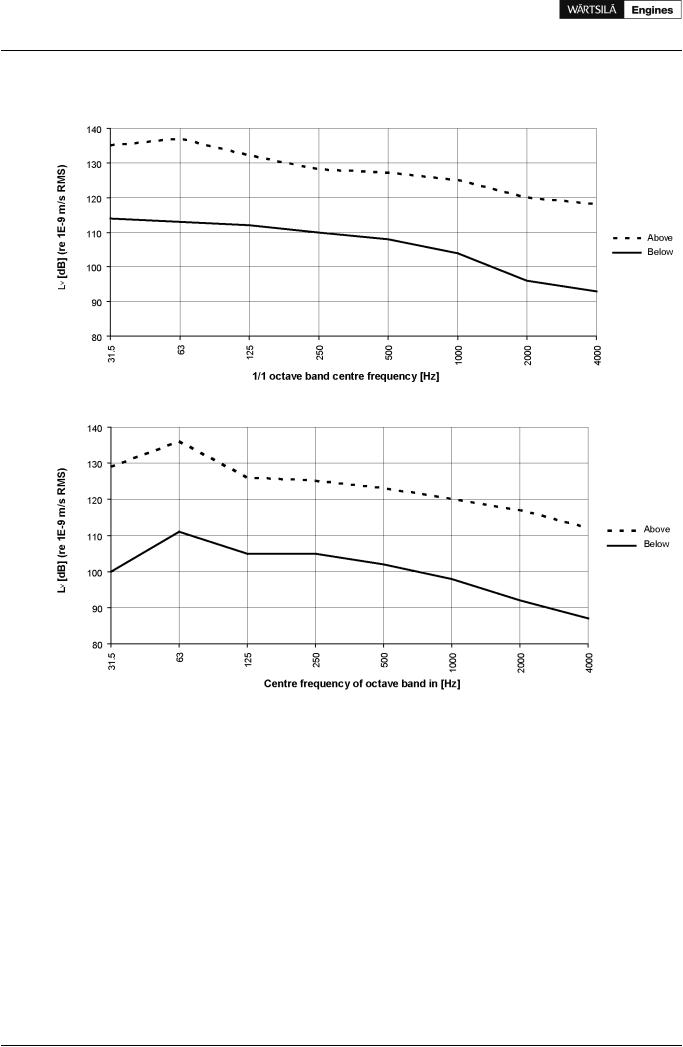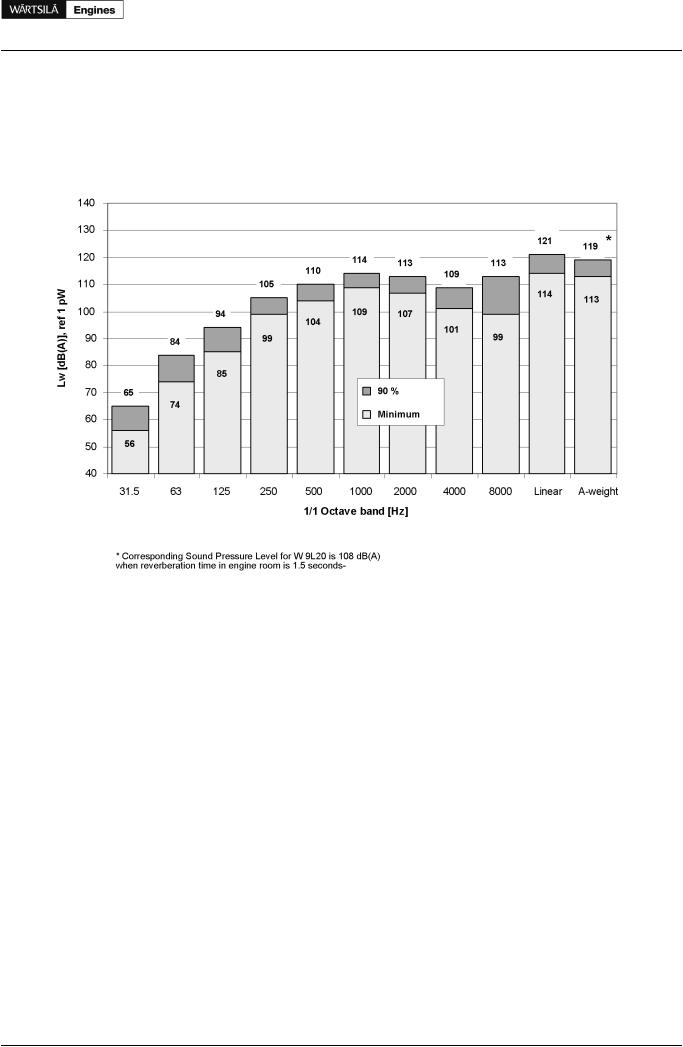
- •Introduction
- •Table of Contents
- •1. Main Data and Outputs
- •1.1 Maximum continuous output
- •1.2 Reference conditions
- •1.3 Operation in inclined position
- •1.4 Dimensions and weights
- •2. Operating ranges
- •2.1 Engine operating range
- •2.2 Loading capacity
- •2.3 Low air temperature
- •2.4 Operation at low load and idling
- •3. Technical Data
- •3.1 Wärtsilä 4L20
- •3.2 Wärtsilä 6L20
- •3.3 Wärtsilä 8L20
- •3.4 Wärtsilä 9L20
- •4. Description of the Engine
- •4.1 Definitions
- •4.2 Main components and systems
- •4.3 Cross sections of the engine
- •4.4 Overhaul intervals and expected lifetimes
- •5. Piping Design, Treatment and Installation
- •5.1 Pipe dimensions
- •5.2 Trace heating
- •5.3 Operating and design pressure
- •5.4 Pipe class
- •5.5 Insulation
- •5.6 Local gauges
- •5.7 Cleaning procedures
- •5.8 Flexible pipe connections
- •5.9 Clamping of pipes
- •6. Fuel Oil System
- •6.1 Acceptable fuel characteristics
- •6.2 Internal fuel oil system
- •6.3 External fuel oil system
- •7. Lubricating Oil System
- •7.1 Lubricating oil requirements
- •7.2 Internal lubricating oil system
- •7.3 External lubricating oil system
- •7.4 Crankcase ventilation system
- •7.5 Flushing instructions
- •8. Compressed Air System
- •8.1 Internal compressed air system
- •8.2 External compressed air system
- •9. Cooling Water System
- •9.1 Water quality
- •9.2 Internal cooling water system
- •9.3 External cooling water system
- •10. Combustion Air System
- •10.1 Engine room ventilation
- •10.2 Combustion air system design
- •11. Exhaust Gas System
- •11.1 Internal exhaust gas system
- •11.2 Exhaust gas outlet
- •11.3 External exhaust gas system
- •12. Turbocharger Cleaning
- •12.1 Turbine cleaning system
- •12.2 Compressor cleaning system
- •13. Exhaust Emissions
- •13.1 Diesel engine exhaust components
- •13.2 Marine exhaust emissions legislation
- •13.3 Methods to reduce exhaust emissions
- •14. Automation System
- •14.1 UNIC C1
- •14.2 UNIC C2
- •14.3 Functions
- •14.4 Alarm and monitoring signals
- •14.5 Electrical consumers
- •15. Foundation
- •15.1 Steel structure design
- •15.2 Mounting of main engines
- •15.3 Mounting of generating sets
- •15.4 Flexible pipe connections
- •16. Vibration and Noise
- •16.1 External forces and couples
- •16.2 Mass moments of inertia
- •16.3 Structure borne noise
- •16.4 Air borne noise
- •17. Power Transmission
- •17.1 Flexible coupling
- •17.2 Clutch
- •17.3 Shaft locking device
- •17.4 Power-take-off from the free end
- •17.5 Input data for torsional vibration calculations
- •17.6 Turning gear
- •18. Engine Room Layout
- •18.1 Crankshaft distances
- •18.2 Space requirements for maintenance
- •18.3 Transportation and storage of spare parts and tools
- •18.4 Required deck area for service work
- •19. Transport Dimensions and Weights
- •19.1 Lifting of engines
- •19.2 Engine components
- •20. Product Guide Attachments
- •21. ANNEX
- •21.1 Unit conversion tables
- •21.2 Collection of drawing symbols used in drawings

Product Guide
16. Vibration and Noise
16. Vibration and Noise
Wärtsilä 20 generating sets comply with vibration levels according to ISO 8528-9. Main engines comply with vibration levels according to ISO 10816-6 Class 5.
16.1 External forces and couples
Some cylinder configurations produce external forces and couples. These are listed in the tables below.
The ship designer should avoid natural frequencies of decks, bulkheads and superstructures close to the excitation frequencies. The double bottom should be stiff enough to avoid resonances especially with the rolling frequencies.
Figure 16.1 Coordinate system
Table 16.1 External forces |
|
|
|
Engine |
Speed [rpm] |
Frequency [Hz] |
Fz [kN] |
W 4L20 |
900 |
30 |
56 |
|
|
60 |
1 |
|
1000 |
33.3 |
69 |
|
|
67 |
1 |
W 8L20 |
900 |
60 |
2 |
|
1000 |
66.7 |
3 |
FZ = 0, FY = 0 and FX = 0 for 6 and 9 cylinder engines
Table 16.2 External couples
Engine |
Speed [rpm] |
Frequency [Hz] |
MY [kNm] |
Frequency [Hz] |
MZ [kNm] |
W 9L20 |
900 |
15 |
7 |
15 |
7 |
|
|
30 |
4.8 |
|
|
|
|
60 |
0.4 |
|
|
|
1000 |
16.7 |
8.6 |
16.7 |
8.6 |
|
|
33.3 |
5.9 |
|
|
|
|
66.7 |
0.5 |
|
|
MZ = 0, MY = 0 for 4, 6 and 8 cylinder engines
120 |
Product Guide Wärtsilä 20 - 3/2009 |

Product Guide
16. Vibration and Noise
16.1.1 Torque variations
Table 16.3 Rolling moments at 100% load |
|
|
|
|
|
||
Engine |
Speed |
Frequency [Hz] |
MX [kNm] |
Frequency [Hz] |
MX [kNm] |
Frequency [Hz] |
MX [kNm] |
|
[rpm] |
|
|
|
|
|
|
W 4L20 |
900 |
30 |
9.9 |
60 |
9.8 |
90 |
3.5 |
|
1000 |
33.3 |
6.6 |
66.7 |
9.6 |
100 |
3.5 |
W 6L20 |
900 |
45 |
15.4 |
90 |
5.2 |
135 |
0.4 |
|
1000 |
50 |
13.4 |
100 |
5.2 |
200 |
0.4 |
W 8L20 |
900 |
60 |
19.6 |
120 |
1.5 |
180 |
0.5 |
|
1000 |
66.7 |
19.3 |
133 |
1.5 |
200 |
0.5 |
W 9L20 |
900 |
67.5 |
17.8 |
135 |
0.6 |
203 |
0.4 |
|
1000 |
75 |
17.7 |
150 |
0.7 |
225 |
0.4 |
Table 16.4 Rolling moments at 0 % load |
|
|
|
|
|
||
Engine |
Speed |
Frequency [Hz] |
MX [kNm] |
Frequency [Hz] |
MX [kNm] |
Frequency [Hz] |
MX [kNm] |
|
[rpm] |
|
|
|
|
|
|
W 4L20 |
900 |
30 |
10 |
60 |
1.4 |
90 |
0.9 |
|
1000 |
33.3 |
13 |
66.7 |
1.3 |
100 |
0.9 |
W 6L20 |
900 |
45 |
4.7 |
90 |
1.3 |
135 |
0.4 |
|
1000 |
50 |
6.8 |
100 |
1.3 |
150 |
0.4 |
W 8L20 |
900 |
60 |
2.8 |
120 |
0.7 |
- |
- |
|
1000 |
66.7 |
2.6 |
133 |
0.7 |
- |
- |
W 9L20 |
900 |
67.5 |
3.6 |
135 |
0.5 |
- |
- |
|
1000 |
75 |
3.6 |
150 |
0.5 |
- |
- |
16.2 Mass moments of inertia
The mass-moments of inertia of the propulsion engines (including flywheel, coupling outer part and damper) are typically as follows:
Engine |
J [kgm²] |
W 4L20 |
90...120 |
W 6L20 |
90...150 |
W 8L20 |
110...160 |
W 9L20 |
100...170 |
Product Guide Wärtsilä 20 - 3/2009 |
121 |

Product Guide
16. Vibration and Noise
16.3 Structure borne noise
Figure 16.2 Main engines, typical structure borne noise levels above and below resilient mounts (DAAB814306)
Figure 16.3 Generating sets, typical structure borne noise levels above and below resilient mounts (DBAB120103)
122 |
Product Guide Wärtsilä 20 - 3/2009 |

Product Guide
16. Vibration and Noise
16.4 Air borne noise
The airborne noise of the engine is measured as a sound power level according to ISO 9614-2. The results are presented with A-weighing in octave bands, reference level 1 pW. Two values are given; a minimum value and a 90% value. The minimum value is the smallest sound power level found in the measurements. The 90% level is such that 90% of all measured values are below this figure.
Figure 16.4 Sound power levels
Product Guide Wärtsilä 20 - 3/2009 |
123 |
